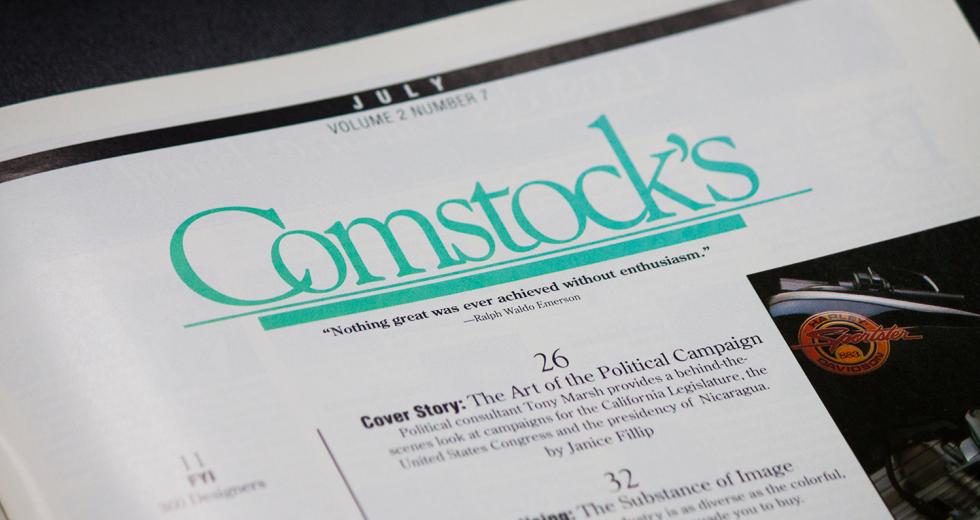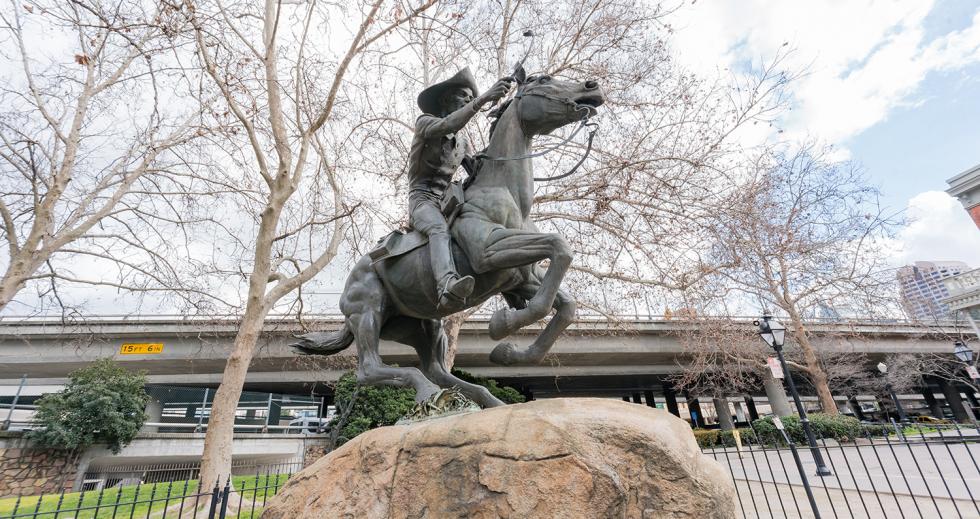The July issue of our magazine has a very recognizable name across its masthead. In fact, this issue marks the 30th anniversary of Comstock’s. Launching and publishing a magazine is not an easy quest, so I smile as I think that 30 years have passed. Of course, this sort of thing can’t be done alone, and I applaud the team members who’ve made it possible: the writers, photographers, artists, editors, sales representatives, circulation managers and accountants through the years; our editorial advisory board; our advertisers without whom we would not have been able to publish even a second issue, much less a 360th. Yes, it is the 360th edition of Comstock’s.
And, of course, we extend our appreciation to you, our readers. We couldn’t do this without you.
I hope you all associate the Comstock name with quality business journalism. But it’s really more than that, and I thought it might be fun to scour a bit through the archives to find out how many other ways the Comstock name has been associated with life in and around Northern California and our Capital Region.
When you ask Google for a “definition of Comstock Lode,” Dictionary.com says: “noun. the most valuable deposit of silver ore ever recorded, discovered in 1859 by Henry T. P. Comstock near Virginia City, Nevada. Also called Comstock Silver Lode.”
Indeed, the Comstock Lode is the most well-known bearer of this name. It was the richest silver mining vein found in the West, 10 years after John Sutter’s discovery of gold helped transform Sacramento, when a rush of miners passed through here on their way to Coloma. Silver was an afterthought when Ethan and Hosea Grosh began looking for gold near Virginia City. But, eventually, the brothers and other miners in the area realized the value of the sticky mud they were digging through and soon after the mine began producing more silver than gold.
Over 20 years, the Comstock Lode produced about $320 million in silver (that’s $9.9 billion in 2019 dollars), creating millionaires by the dozens, including Leland Stanford and George Hearst. Unfortunately, the namesake for the lode,
Henry Tompkins Paige Comstock, was not one of them. A friend of the Grosh brothers, the eccentric miner known as “Old Pancake” laid claim to their stake after both brothers died in 1857. That’s when Comstock found information in their cabin that led him to the claim, where he convinced two other miners that the stake was his.
Like many people in the earliest days of the Comstock Lode, he had little money to work with and no way to predict the excessive riches that lay ahead. I always heard he lost the stake in a poker game to a member of the Hearst family. But history books suggest he sold his stake in the Comstock Lode for $15,000 and used the money to open a store in Carson City that he later lost because he wasn’t a very good businessman. Although he didn’t share in its immense wealth, the Comstock name is forever linked to the silver vein.
Beyond the wealth it created, the Comstock Lode contributed to advancing timbering techniques that made mining safer and prompted the design of more efficient pumping equipment. And perhaps its most important contribution to history was its role in gaining statehood for Nevada. The wealth created by the Comstock Lode caught the attention of President Abraham Lincoln, who needed money to pay Civil War expenses. Even though it did not have the population required by the constitution, Nevada had enough silver and gold to gain statehood in 1864.
In the same year, William Dutton Comstock arrived in San Francisco after leaving New England, and he soon migrated to Sacramento to work as a clerk in a mercantile shop. Before long, he opened a store of his own and Comstock Furniture became a long-time fixture on the northeast corner of Fifth and K streets in Sacramento.
William Dutton Comstock was also civic minded and played a role in developing Sacramento as a city. Initially elected to the Board of Fire Commissioners, he resigned to become mayor of Sacramento in 1890. According to the city’s archives, “Mr. Comstock and his family occupy a lead position in social circles and all who pass through the portals of their cultured home enjoy a most cordial hospitality.”
His daughter, Sophia P. Comstock, also played a role in Sacramento’s civic life. After graduating from Sacramento High School in 1889 and UC Berkeley in 1893, she taught Latin and English literature in Elk Grove for many years. Sophia Comstock’s estate helped fund the effort to erect the nearly two-ton bronze statue on the corner of Second and J streets in Old Sacramento that commemorates Sacramento as the western terminus of the Pony Express. It was dedicated on June 4, 1976, by the Sophia Comstock Memorial Committee.
The Comstock name has lived on in many ways. Old Pancake’s legacy also lives on in the Comstock Saloon in San Francisco’s financial district. The now-defunct Comstock Air Service once connected Sacramento to other cities in the western United States from Executive Airport. Wineries and schools carry the Comstock name for geographical or historical reasons, as did Comstock Mortgage, which had a very visible presence in our region from 1989 until it became known as Guild Mortgage in 2016.
Other Comstock-named companies were owned by direct descendants of Old Pancake, including our branch of the family where my grandchildren are seventh-generation Sacramentans. Don Comstock, Comstock Johnson
Architects’ cofounder, also is a descendent.
Of course, over many generations, any family will have some relatives they might not wish for. By most accounts, Old Pancake was a conniving scoundrel, willing to do anything he could get away with to get ahead. If he were alive, he might still be invited to dinner, but only if the silverware was counted before he went home.
And the same could be said for people who might be mistaken for relatives. Anthony Comstock is infamous for the Comstock Laws of the late 1800s. As the founder of the New York Society for the Prevention of Vice, he promoted anti-obscenity laws that considered even referring to birth control in a letter to be illegal pornography. “Comstockery,” as it was called, is still defined as “strict censorship of materials considered obscene.”
The Comstock Laws were eventually ruled unconstitutional and Anthony Comstock was unmasked as a prudish morals policeman. Fortunately, we aren’t related. But if we were, we would have a lot of fun making him blush at family reunions.
In short, it’s a bit whimsical and fun to think of the many ways the Comstock name has been and is used and the many things people associate with it, whether it’s wealth, technical innovation, civic life, a magazine or simply carrying on the legacy of interesting characters.
We hope when you see Comstock’s magazine come across your desk each month, you continue to think of it as a source for valuable insight and information that helps you be more successful in business.
That’s how we prefer to define “Comstockery.”
Winnie Comstock-Carlson
President and Publisher







Comments
Congratulations Winnie on your milestone. Loved reading about the Comstock legacy.
Tomorrow is 11-29, my 71st birthday. I only discovered this site yesterday and only just now found out that there was a magazine.
My Grandmother was Ruby Winifred Comstock. Born in 1899. Her parents died when she was young . She was an only child and an orphan. She grew up and had 13 children. My Mom was number 5. She was born in 1927. Long story of my Gramma when her first husband was shot and killed in Chicago. And she had a newborn baby. She and her baby were going to end it all and jump off the bridge in Rock Island. Illinois. Marie Louise Marshall rescued them and took her in. She met and married her second husband mr. ASBELL. and had 12 more children..he died ( typhoid fever complication) ( from when he was in africa during WW1)when the youngest was two. And Gramma raide them all as a single Mom. During the depression. Somehow my family doesn't think that was such a big deal. I do!
I did not know of Comstock’s publication. I am interested. If you would send me information I would appreciate it. Thanks
My Grandma's name on my Dad's side was Hazel Rose Kelm, she was the daughter of Mrytle Johnson and Francis Llewlyn Comstock of Rockford, Illinois! I would like to know more of the Comstock family. My Father(Clarence A.Kelm)was taken in by his Aunt Sylvia Jeanette Comstock and his Uncle IRA Stevens when he was around 3yrs. old, his Grandpa Francis Llewlyn Comstock lived on the Johnson farm for many years after his Grandma Myrtle separated/divorced or what
ever from him. For many years now I've been doing genealogy research on both my Dad's family and my Mom's. How Henry Thompkins Paige is related or not I don't know yet,
just want to know
more about my family,who is who and what is what. My Dad just said we could be related to the Comstock Lode
guy!
I am a Comstock from West Virginia. My grandfather was Jim Comstock, publisher of The West Virginia Hillbilly newspaper.
I’m not sure if my comment was received. My grandfather was Jim Comstock, publisher of The West Virginia Hillbilly. I am very proud of the Comstock name.